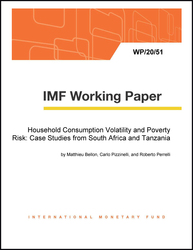
Household Consumption Volatility and Poverty Risk: Case Studies from South Africa and Tanzania
Household Consumption Volatility and Poverty Risk: Case Studies from South Africa and Tanzania
READ MORE...
Volume/Issue:
Volume 2020
Issue 051
Publication date: March 2020
ISBN: 9781513527017
$18.00
Add to Cart by clicking price of the language and format you'd like to purchase
Available Languages and Formats
| English |
Prices in red indicate formats that are not yet available but are forthcoming.
Topics covered in this book
This title contains information about the following subjects.
Click on a subject if you would like to see other titles with the same subjects.
Labor , Economics- Macroeconomics , Poverty and Homelessness , WP , Tanzania , consumption volatility , food consumption , consumption fluctuation , consumption deviation , consumption level , counterfactual consumption allocation , consumption loss , Consumption , Income , Household consumption , Employment , Africa , Sub-Saharan Africa , Poverty , South Africa
Summary
Economic volatility remains a fact of life in Sub Saharan Africa (SSA). Household-level shocks create large consumption fluctuations, raising the incidence of poverty. Drawing on micro-level data from South Africa and Tanzania, we examine the vulnerability to shocks across household types (e.g. by education, ethnic group, and economic activity) and we quantify the impact that reducing consumption volatility would have on aggregate poverty. We then discuss coverage of consumption insurance mechanisms, including financial access and transfers. Country characteristics crucially determine which household-level shocks are most prevalent and which consumption-smoothing mechanisms are available. In Tanzania, agricultural shocks are an important source of consumption risk as two thirds of households are involved in some level of agricultural production. For South Africa, we focus on labor market risk proxied by transitions from formal employment to informal work or unemployment. We find that access to credit, when available, and government transfers can effectively mitigate labor market shocks.
Copyright © 2010 - 2025
Powered by:
AIDC



